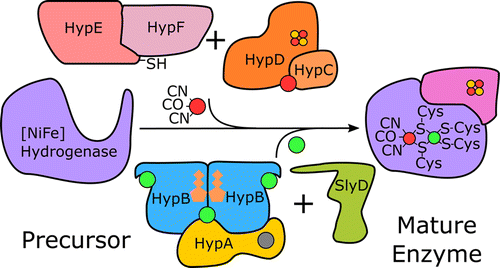当前位置:
X-MOL 学术
›
Biochemistry
›
论文详情
Our official English website, www.x-mol.net, welcomes your
feedback! (Note: you will need to create a separate account there.)
[NiFe]-Hydrogenase Maturation
Biochemistry ( IF 2.9 ) Pub Date : 2016-03-14 00:00:00 , DOI: 10.1021/acs.biochem.5b01328 Michael J. Lacasse 1 , Deborah B. Zamble 1, 2
Biochemistry ( IF 2.9 ) Pub Date : 2016-03-14 00:00:00 , DOI: 10.1021/acs.biochem.5b01328 Michael J. Lacasse 1 , Deborah B. Zamble 1, 2
Affiliation

|
[NiFe]-hydrogenases catalyze the reversible conversion of hydrogen gas into protons and electrons and are vital metabolic components of many species of bacteria and archaea. At the core of this enzyme is a sophisticated catalytic center comprising nickel and iron, as well as cyanide and carbon monoxide ligands, which is anchored to the large hydrogenase subunit through cysteine residues. The production of this multicomponent active site is accomplished by a collection of accessory proteins and can be divided into discrete stages. The iron component is fashioned by the proteins HypC, HypD, HypE, and HypF, which functionalize iron with cyanide and carbon monoxide. Insertion of the iron center signals to the metallochaperones HypA, HypB, and SlyD to selectively deliver the nickel to the active site. A specific protease recognizes the completed metal cluster and then cleaves the C-terminus of the large subunit, resulting in a conformational change that locks the active site in place. Finally, the large subunit associates with the small subunit, and the complete holoenzyme translocates to its final cellular position. Beyond this broad overview of the [NiFe]-hydrogenase maturation process, biochemical and structural studies are revealing the fundamental underlying molecular mechanisms. Here, we review recent work illuminating how the accessory proteins contribute to the maturation of [NiFe]-hydrogenase and discuss some of the outstanding questions that remain to be resolved.
中文翻译:

[NiFe]-氢化酶成熟
[NiFe]-加氢酶催化氢气向质子和电子的可逆转化,是许多细菌和古细菌的重要代谢成分。该酶的核心是一个复杂的催化中心,该催化中心包含镍和铁以及氰化物和一氧化碳配体,它通过半胱氨酸残基锚定在较大的氢化酶亚基上。该多组分活性位点的产生是通过辅助蛋白的收集来完成的,并且可以分为离散的阶段。铁成分是由蛋白HypC,HypD,HypE和HypF形成的,它们可以用氰化物和一氧化碳对铁进行功能化。铁中心信号的插入给金属伴侣蛋白HypA,HypB和SlyD选择性地将镍传递到活性位点。特定的蛋白酶识别完成的金属簇,然后切割大亚基的C末端,导致构象变化,从而将活性位点锁定在适当的位置。最后,大亚基与小亚基缔合,完整的全酶转移至其最终细胞位置。除了[NiFe]-氢化酶成熟过程的广泛概述之外,生化和结构研究还揭示了基本的潜在分子机制。在这里,我们回顾了最近的工作,阐明了辅助蛋白如何促进[NiFe]-氢化酶的成熟,并讨论了一些尚待解决的悬而未决的问题。大亚基与小亚基缔合,完整的全酶转移到其最终细胞位置。除了[NiFe]-加氢酶成熟过程的广泛概述之外,生化和结构研究还揭示了潜在的基本分子机制。在这里,我们回顾了最近的工作,阐明了辅助蛋白如何促进[NiFe]-氢化酶的成熟,并讨论了一些尚待解决的悬而未决的问题。大亚基与小亚基缔合,完整的全酶转移至其最终细胞位置。除了[NiFe]-氢化酶成熟过程的广泛概述之外,生化和结构研究还揭示了基本的潜在分子机制。在这里,我们回顾了最近的工作,阐明了辅助蛋白如何促进[NiFe]-氢化酶的成熟,并讨论了一些尚待解决的悬而未决的问题。
更新日期:2016-03-14
中文翻译:

[NiFe]-氢化酶成熟
[NiFe]-加氢酶催化氢气向质子和电子的可逆转化,是许多细菌和古细菌的重要代谢成分。该酶的核心是一个复杂的催化中心,该催化中心包含镍和铁以及氰化物和一氧化碳配体,它通过半胱氨酸残基锚定在较大的氢化酶亚基上。该多组分活性位点的产生是通过辅助蛋白的收集来完成的,并且可以分为离散的阶段。铁成分是由蛋白HypC,HypD,HypE和HypF形成的,它们可以用氰化物和一氧化碳对铁进行功能化。铁中心信号的插入给金属伴侣蛋白HypA,HypB和SlyD选择性地将镍传递到活性位点。特定的蛋白酶识别完成的金属簇,然后切割大亚基的C末端,导致构象变化,从而将活性位点锁定在适当的位置。最后,大亚基与小亚基缔合,完整的全酶转移至其最终细胞位置。除了[NiFe]-氢化酶成熟过程的广泛概述之外,生化和结构研究还揭示了基本的潜在分子机制。在这里,我们回顾了最近的工作,阐明了辅助蛋白如何促进[NiFe]-氢化酶的成熟,并讨论了一些尚待解决的悬而未决的问题。大亚基与小亚基缔合,完整的全酶转移到其最终细胞位置。除了[NiFe]-加氢酶成熟过程的广泛概述之外,生化和结构研究还揭示了潜在的基本分子机制。在这里,我们回顾了最近的工作,阐明了辅助蛋白如何促进[NiFe]-氢化酶的成熟,并讨论了一些尚待解决的悬而未决的问题。大亚基与小亚基缔合,完整的全酶转移至其最终细胞位置。除了[NiFe]-氢化酶成熟过程的广泛概述之外,生化和结构研究还揭示了基本的潜在分子机制。在这里,我们回顾了最近的工作,阐明了辅助蛋白如何促进[NiFe]-氢化酶的成熟,并讨论了一些尚待解决的悬而未决的问题。































 京公网安备 11010802027423号
京公网安备 11010802027423号